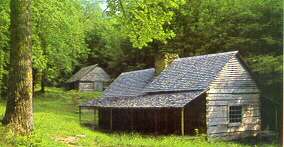Echoes From The Past
By JUDY MAUPIN
*- Echoes From the Past
(A Column of historical and genealogical anecdotes, stories and family notes.)
Calloway County, Ky.
19th Century Farm
March 1, 1980
Two years ago this month I did a
series of articles on Lucy Jefferson Lewis and her sons. For those of you who are not acquainted with this name, Lucy was Thomas Jefferson's sister; she and her husband Dr. Charles Lewis emigrated from Virginia to &nlthland, in Livingston County, Kentucky, Just before 1800.
Lucy is buried in a grave deep In the woods on a bluff overlooking the Ohio River, with a very simple; and almost impossible to find, gravestone. Since I researched the story of her life in Kentucky, a Kentucky historian, Boynton Merrill, of Henderson, has written a very Interesting book entitled Jefferson's Nephews. He not only narrates the story of Lucy and her family, but gives a very in-depth description of life In the early 1800's.
When I went to Smithland to try to find Rocky Hifi, the Lewis Farm, there was nothing left of the house in which the family lived. It has evidently been gone for many years. For this reason, I was Intrigued at the description Mr. Merrill has pieced together from his research, of the Lewis home. The following description Is his:
"The farming equipment that the two brothers owned seems hopelessly Inadequate today. With no more than $45 worth of farm tools between them, these men had every reason to expect to feed and clothe their families and slaves and reap some small profit in addition. The three most Important tools were the hoe, the axe, and the plow. The brothers together owned four plows worth only about a dollar each.
They had seven axes, seven hoes, and a few other implements: sheep shears, wedges, beam scales, harness and gear for the horses, a hammer, clivis, grindstone, mattox, and two sleighs. The sleigh, also called ground sle or landslide, took the place of the wagon In frontier life. It was a simple box or platform built across two timber runners. Anything too heavy or bulky to be hauled on a horse was slid over the ground on a sled pulled by a horse.
"The Lewises did not own any wagons in Kentucky. The public roads did not run near the Lewis farms, and even If they 'had, wagons would not have been dependable transportation because of the execrable condition of the roads. Had the Lewises come west by wagon Instead of by boat, they would have had to cut at least three miles of wagon road before they could even reach their own farms.
"Once the Lewises had planted their crops, they could have turned their full attention to completing their homes. No desciIption of their houses exists but the legends are unanimous in stating that the Lewis residences were larger than the usual house built at that time In Western Kentucky.
"The list of Lilburn's (Lucy's son) furniture roughly Indicates the minimum which would take up space, and omits kitchen equipment,... and other small Items: 6 bedsteads and one trundle bed, 3 tables, 12 chaIrs, 2 spinning wheels and a reel, 1 bookcase and about 50 books, 1 backgammon table, 1 dressing box, 3 trunks and 2 bureaus.
"At the very least, Lilburn's house must have had two or more bedrooms, a dining room, parlor, and kitchen. During that period persons who had servants usually built a separate one-room building for the cooking, so the odors, heat, noise and mess of preparing food and cleaning up after meals would not disturb the family.
"The kitchen was attached to the house by a walkway that was called a dogtrot. At a discreet distance from the
house the privy would be located, and at a somewhat greater distance the slave quarters and corn crib were built. When time permitted , a barn or stable for the horses may have been added to these buildings."
Next week, we wifi continue with Mr.
Merrill's description of life on an early 1800 farm In Western Kentucky.

